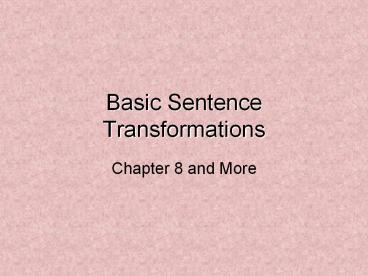Basic Sentence Transformations - PowerPoint PPT Presentation
1 / 13
Title:
Basic Sentence Transformations
Description:
To make the Verb less active and more stative. Agentless Passives (He was fired.) Get Passives (He got fired by the boss.) Resultative Adjectives (He is/got drunk. ... – PowerPoint PPT presentation
Number of Views:382
Avg rating:3.0/5.0
Title: Basic Sentence Transformations
1
Basic Sentence Transformations
- Chapter 8 and More
2
Reason for Transformations
- Canonical vs. non-canonical
- Arbitrariness vs. Iconicity
- Proximity
- First things first
- More important before less important
- Conceptually close things - e.g. noun phrase
3
Passives
- Functions
- To demote the Agent
- To promote the Patient
- To make the Verb less active and more stative
- Agentless Passives (He was fired.)
- Get Passives (He got fired by the boss.)
- Resultative Adjectives (He is/got drunk.)
4
Passives and Style
- Student writers are often discouraged from using
passives. (if youll pardon my passive) - They can create confusion or be difficult to
process (p. 248) - They can make the sentence more wordy
- Sometimes, they are useful (p. 249)
5
Indirect Object Transformation
- Moving the indirect object (to/for NP) before
the direct object and eliminate the preposition. - He gave him the present. (lt He gave the present
to him.) - He baked me a cake. (lt He baked a cake for me.)
- Function to promote the indirect object
- Doesnt work if the indirect object is a place
adverbial. (He drove Chicago the car.) - Indirect object is the recipient or benefactor of
the direct object
6
Object Complements
- Object complements refer to the direct object
- I consider him a fool. I want him arrested.
- If an object complement is an NP, then the
sentence has two NPs after the verb - Pages 239-240 Edwin considers/bought Eleanor a
jewel.
7
Question Transformations
- Wh-Question
- Invert the subject and the first auxiliary
- Move the Wh-Word to the front
- Whom will he choose?
- Yes-No Question
- Invert the subject and the first auxiliary
- Will he choose me?
- Tag Question
- At the end of the sentence, put the first
auxiliary followed by not if the sentence is
positive and then a pronominal form of the
subject - Hell choose me, wont he?/He wont choose me,
will he?
8
Hierarchy of Certainty in Questions
Answer Unknown
Answer Known
9
Diagramming Wh-Questions
we
will eat
What
S
VP
NP
NP
MVP
Pronoun
AUX
MV
Pronoun
we will eat
what
10
Examples of Wh-Questions
- Subject (Who is here? What bit me?)
- Direct Object (Whom did you call? What will we
eat?) - Indirect Object (To whom did you give the present
to? For whom did you bake the cake?) - Object of a preposition (In whom shall we place
our trust? Onto what did you put the book.) - Possessor (Whose book is this? In which/what box
will we find the candy?)
11
Other Transformations
- Imperative
- Understood second person subject (sg. or pl.)
- Open the door.
- Negative
- Put not after the first auxiliary
- Tom doesnt like me.
- Left Dislocation (Tom, he likes me.)
- Y-Movement (Tom he likes.)
12
Four uses of the Verb, Be
- As a linking verb (e.g., They are nice.)
- As an auxiliary with the present participle form
of the main verb to form the progressive (They
are dancing.) - As an auxiliary with the past participle form of
the main verb to form the passive (They were
surprised by the answer.) - As an existential (There is a Santa Claus.)
- Exercise 8.9, p. 253
13
Rules involving the first auxiliary
- Wh-Question, Yes/No-Question, Tag Question,
Negative - If a sentence does not have a first auxiliary,
then insert do as the first auxiliary. - If the main verb is Be, do not insert do.































